Introduced in season 1 is the new concept of regional markets. Where most products in Mercatorio are traded on markets located in a specific town (either your own or one you're visiting), ships and carts are now traded on regional markets. This increases the volume traded and helps with price discovery, and given that ships and carts are made for moving around the world, it makes sense that they are less tied to specific locations than other goods. For more details about how movement of those other goods is handled, check out the Space, storage and transport article
Trading mechanics
The Market mechanics article explains in depth how prices are set, but we'll recap some here.
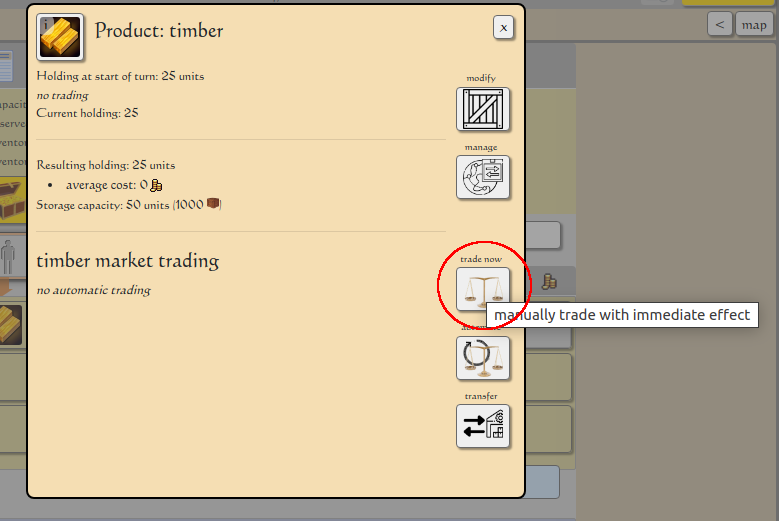
Whenever you're in a building or project handling products, you can click the product bar to see details, and initiate manual (or automated trades) on the local market.
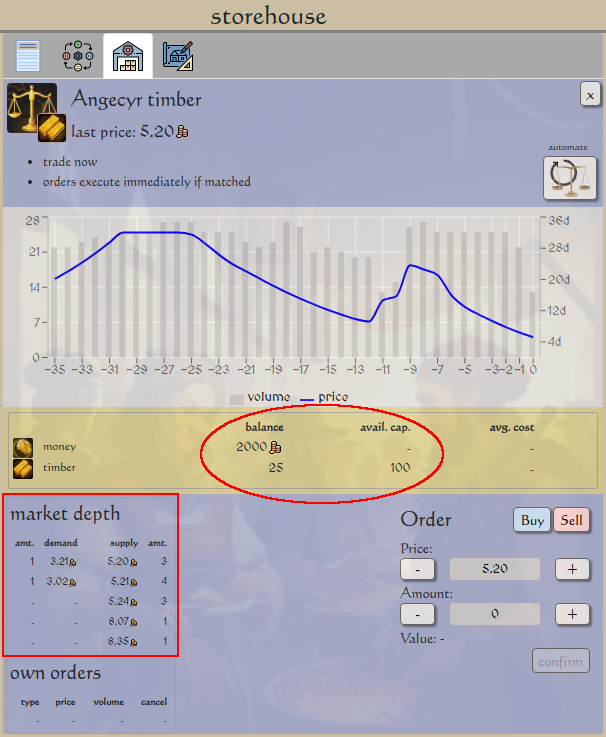
Looking at the timber market in our hometown Angecyr from the perspective of our storehouse. We already have 25 stacks of timber and capacity for 100, as well as 2000 coins. The market depth shows current pending buy and sell orders on the market. These are orders entered by market participants, manually or automatically, that haven't been filled. For immediate trading, these are the orders we can trade against.
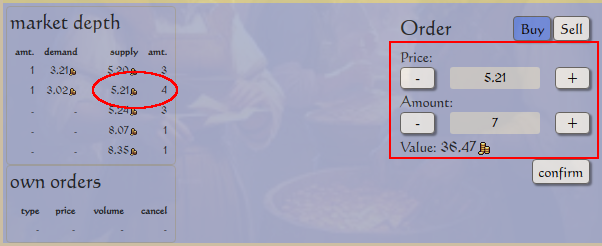
We can enter our desired price and volume ourselves, or we can just click the order we want to trade against to get it filled for us. By clicking the 4 items being sold for 5.21, we will also get the 3 at 5.20. Being the active party, the market will automatically optimize the prices we pay, so buying all 7 with one order costs no more than entering separate orders at each price point. In fact, we could set our price at eg. 100.00, and we'd still pay 5.20 and 5.21 respectively as long as the volume was 7 (we would run the risk that prices changed momentarily before the order was entered though, so this isn't a recommended approach).
If we enter a price lower than the lowest asking price (5.20), our order will not get filled and end up among the pending ones.
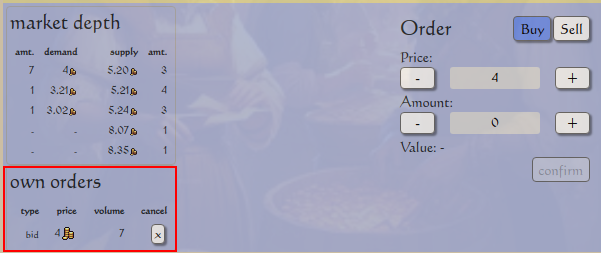
This doesn't usually make sense for regular products unless there's a lot of manual trading in the town, but as we'll see in a moment, it can be useful for larger purchases like ships.
Reservations
It's worth noting an important implication of having pending orders, whether they are left-overs from automated trading or entered manually. Since your pending orders can get executed at any time, as a result of someone else's trade, you are required to actually have the product available (when selling) or the money and space available (when buying). This is handled by reserving the relevant quantities.
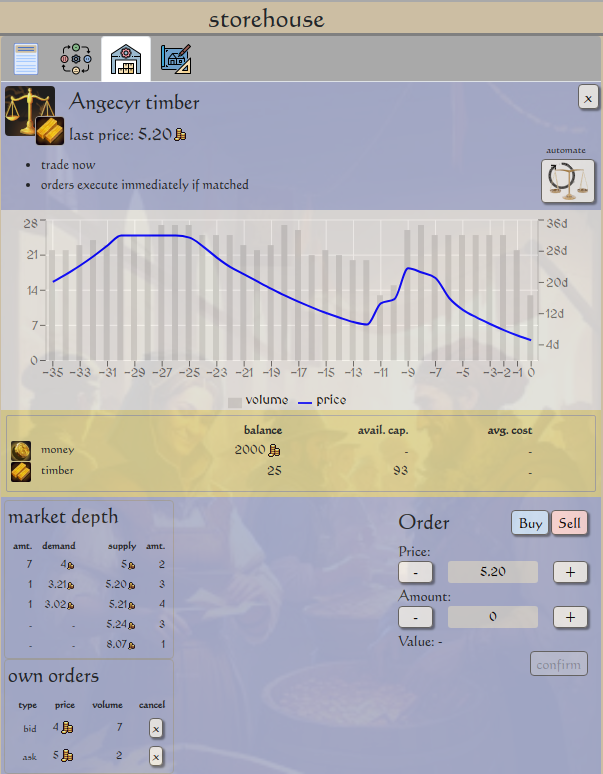
Let's say we have the following orders pending: a bid to buy 7 timber at 4.00 and an ask to sell 2 timber at 5.00. Here we have entered those orders manually, but it would look the same if they were left over after the start-of-turn auction. They are pending, so no trade has taken place, but it still has an effect both on our timber inventory and our bankroll. We now have 28.00 coins and 7 timber stacks of storage space reserved for the bid and 2 timber stacks reserved for the ask.
The former is already visible on this screen in the reduced available capacity, and if we go back to the timber details, we'll see the full situation:
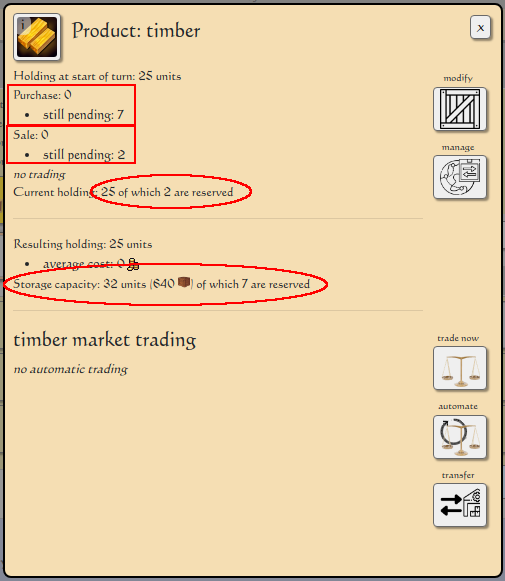
This is relatively straight-forward in our example, but it is something to be aware of when there are trade routes originating at the storehouse, as these will make their own reservations as well. If there are many large trade orders going unfilled, there can be lots of space and products locked up in reservations.
Regional markets
So far we have only been interacting with our local market, and for a product like timber there will usually be a steady stream of supply and demand going through the market, giving a well defined price. This may not be the case for products with a larger price-tag, like ships, which trade comparatively rarely. Regional markets improve upon that.

You can find the map of the world in the menu, showing all the towns grouped by region. Our town Angecyr is located in the region of Brittabourg, with the capital Stutthen. The towns of the region are highlighted, with the capital Stutthen enlarged, and our hometown even more enlarged.
For visitors to the region, the regional market can be found in the capital. When trading within your own region, it can be accessed from any town.
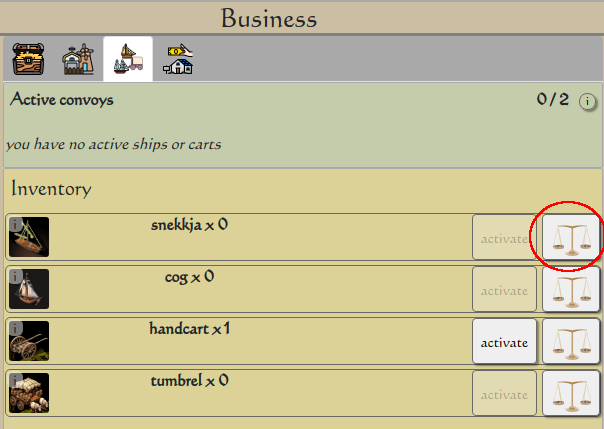
The page for ships and carts show that we have our starting handcart, but wanting to travel over sea, we're looking to buy a snekkja. The regional snekkja market can be accessed by clicking the market icon.
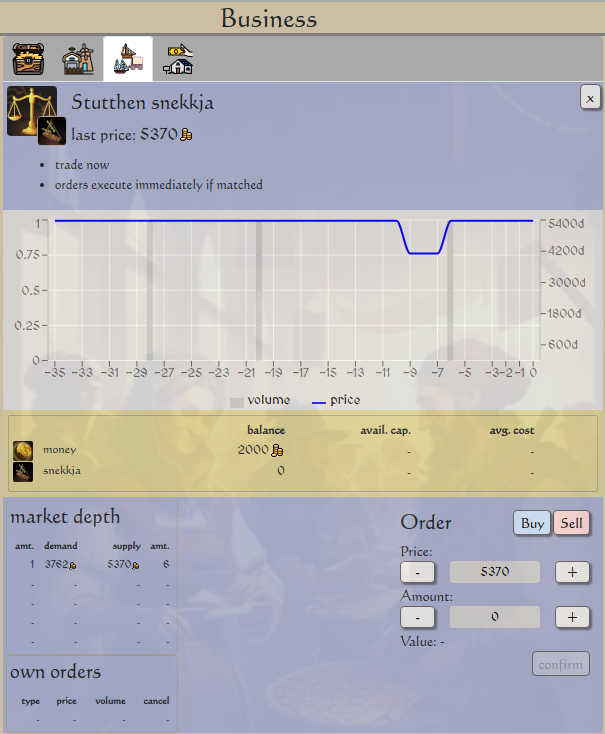
The market for snekkjas operate the same way as for timber, except being located in the capital Stutthen. We can see that even with all the trades in the region centralized to one market, there is much less volume, with many turns passing between each trade.
Long time pending
There is no automated trading for this market, and given the price tags, it can often make sense to enter a manual order at price too low to execute.
If we want to immediately purchase a snekkja, we have to fork out 5370 coins, while we can have the highest bid on the market for 3763 coins, a rather large spread. Having the highest bid (or lowest ask when attempting to sell) means that when another market participants comes to trade, your order will be the first to execute. So if you don't need the ship right away, you save a good amount of coins by putting in an order at 3763 and waiting for the next sale to take place. Of course, the person or bot with the order at 3762 may also realize that they are willing to offer more to be first in line and up their bid.
In our case, this is a moot point of course, as we don't have the funds to offer anything near that price at the moment. Yet...
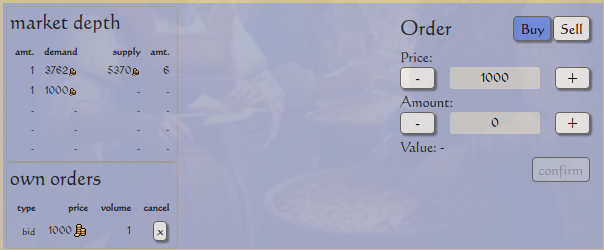
Instead we go for another strategy and enter a low-ball bid of 1000. We won't be first in line, but if we don't need the money for another investment, we can always hope that someone is desperate enough to sell that they will accept our offer.
Note that the 1000 coins are now reserved and can't be used for anything else, not even other bids. As mentioned, we don't control when this order will execute, and we're not allowed to be short of funds if it executes. If this is a strategy you want to employ, make sure it doesn't interfere with other operations and their automated trading.



